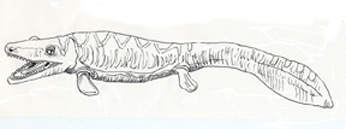Extracting Mosasaur Protein – A New Scientific Paper is Published
Swedish Scientists Extract Collagen from 70-million-year-old Sea Monster
A team of scientists from Lund University (southern Sweden) have published a paper in the online scientific journal PLoS One on their work to extract the traces of preserved protein molecules from a marine reptile (mosasaur) from the Late Cretaceous.
The animal in question, is a member of the Squamata specifically the fossilised remains of a mosasaur called Prognathodon. Mosasaurs were a group of large and powerful sea-living lizards which thrived in marine environments during the Late Cretaceous. It is believed they are closely related to Monitor Lizards. They were the only family of lizards to become extinct at the end of the Mesozoic. Some mosasaurs were apex predators and grew to lengths in excess of 12 metres long.
An Illustration of a Typical Mosasaur (Tylosaurus)

Picture credit: Everything Dinosaur
Mosasaur
The scientists analysed at a microscopic level traces of collagen protein found inside the fossilised upper forelimb (humerus) of this long, extinct marine reptile. The density of the bone may have helped preserve the protein fragments over seventy million years. Collagen is an important protein as it forms connective tissues such as ligaments.
Although other scientists have claimed to have recovered proteins from Cretaceous dinosaurs, this is the first find of preserved tissues from a marine environment and the first time they have been found within a fossilised forelimb.
Tiny Fibres
Pictures show a close up analysis of tiny fibres (matrix fibrils) preserved in the mosasaur fossil bone. Top left, histologic preparation that show how the fibres surround a vascular duct in the bone. Top right, SEM-picture that reveals etched fibres (extreme magnification). Bottom left, close up of histologic preparation showing fibres encapsulated in bioapatite. Bioapatite is a phosphate based mineral complex made as a result of microscopic biological processes. Bottom right, histo-chemical stain (blue vein effect) indicating that the fibres contain biological matter.
To read an article on Manchester University’s work on the analysis of “Dakota” a beautifully preserved Edmontosaurus dinosaur, known as a dinosaur “mummy”, click the link below:
Manchester University article: Amazing Dinosaur Mummy Yields More Secrets.
The Swedish researchers note that the earlier ancient protein extractions have been controversial, but note that their new research is backed up by several tests to corroborate the tissue’s authenticity. The research team used infrared microspectoscopy, mass spectrometry, and a chemical analysis on the ancient sea-going predator’s remains to make sure what they had found was not contamination from bacteria or other modern sources.
Despite this new scientific study, the researchers are quick to state that they are a long way from creating living tissue from these remains. Creating a watery “Jurassic Park” ruled by giant sea lizards is still very much in the realms of fantasy.
For fishermen, sailors and swimmers this is probably a very good thing.
For scale models of marine reptiles including mosasaurs: CollectA Deluxe Scale Prehistoric Animal Models.

